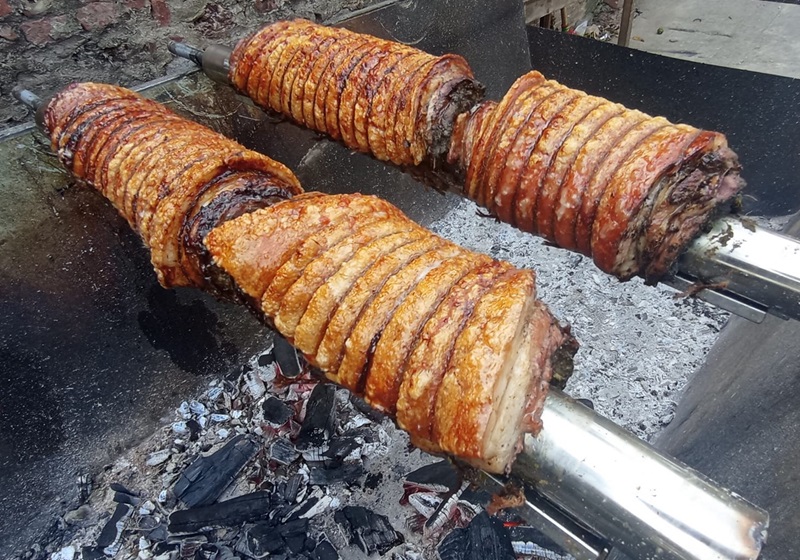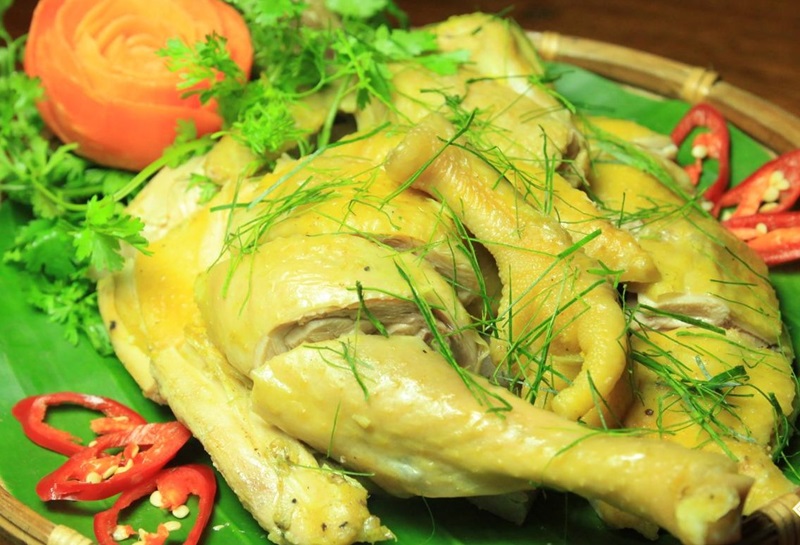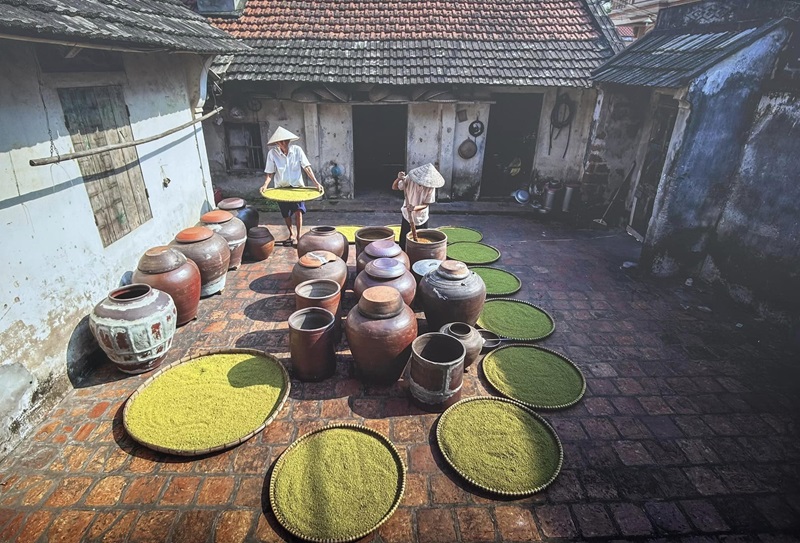Countryside delicacies in Duong Lam Ancient Village
The dishes here are suitable for the whole family to enjoy, while parents can tell their children old stories.
Not at all a new destination for Hanoi people, Duong Lam Ancient Village in Son Tay Town on the outskirts of Hanoi is never empty of visitors. In addition to the charm of the century-old houses and winding alleys, the ancient vibes, cozy atmosphere, and excellent cuisine attract families to bring their children here whenever they have an opportunity.
| Visitors to the ancient village of Duong Lam in Hanoi. Photo: Huy Pham |
Thit quay gion - Roast pork
Thit quay gion, or roast pork on a stick, is famous for its elaborate recipe - a batch can take up to... six hours! Starting with meat selection, Duong Lam cooks are only satisfied with fresh belly pork with thick skin but not too much fat. The selected pork is marinated in spices, pepper, fresh shallots, hung liu or a special Vietnamese spice mixture, and guava leaves.
The last ingredient is considered the key to the flavor of this dish. Only young guava leaves are picked, then chopped and mixed with the pork for about 1 hour. More mature - but not dry - leaves are stuffed into the pieces of pork before roasting. After soaking, they are rolled up and wrapped around bamboo sticks with banana leaves in between.
| Thit quay gion or roast pork on a stick - a specialty of Duong Lam Ancient Village. Photo: Ha Hai |
The roasting stage also has its own standards. The pieces of pork must be about 50 cm above the fire. When the meat is a little firm, the distance is reduced to about 30 cm. The cook must not rush but carefully maintain the proper distance and let the pork cook slowly. When the piece of pork tightens and the fat drains off, the sticks are lowered to give it a striking color.
A successfully roasted piece of belly pork must have a crispy and puffy skin, which is pierced with a bamboo skewer until it makes popping sounds. The meat is also coated with a thin layer of honey to enhance its fragrance and flavor when cooked.
Ga Mia hap - Steamed sugarcane chicken
In Duong Lam, there is a breed of chicken named after the old name of the village: Ga Mia or Sugarcane Chicken. In the past, these chickens were only offered to royalty or on important occasions such as Tet (Lunar New Year), holidays, or incense burning ceremonies at village festivals, symbolizing prosperity. Raised on a diet of corn, cassava and rough rice, they are small, weighing only about two kilos, but their meat is very firm.
| The dish of Ga Mia hap or steamed Sugarcane Chicken. |
Today, these valuable chickens are raised and served to tourists visiting the ancient village. Ga Mia is often steamed to preserve its strong, savory flavor. However, if you want to enjoy it properly, you must wait for it to cool - then you can feel the sweetness and aroma of each fiber.
Che lam - nutty ginger sticky rice bars
In the suburbs of Hanoi, many places make che lam - nutty ginger sticky rice bars, but the one made by the people of Duong Lam Ancient Village still has its distinctive flavor. Che lam here is chewy, with the aroma of toasted glutinous rice flour and ginger and the sweetness of molasses and malt.
Visitors can tour the production facilities housed in century-old houses and see firsthand the process of making che lam. In addition, food stalls around the village feature female vendors who often display the sweet in large chunks on a tray and cut it to order.
| The dish of che lam. Photo: Xuan Minh |
Che lam is also sold alongside childhood sweets such as peanut candy or sausage candy - rustic snacks with rural flavors.
Visitors should also try traditional leaf-wrapped cakes such as banh te (pork-stuffed rice cakes in banana leaves), banh nep (sticky rice cakes with green beans in banana leaves), banh gai (thorn leaf cakes), banh gio (Vietnamese-style rice dumplings), or banh duc (plain rice cakes with peanuts) while wandering around Duong Lam.
Tuong nep - fermented soybean paste
On the village streets and in the houses, especially in Mong Phu hamlet, tourists can easily find large yards filled with large clay jars. The locals here have a traditional craft of making tuong nep, or fermented soybean paste, which is hundreds of years old. Duong Lam's tuong nep has an unforgettable sweet and buttery taste that can't be confused with anything else. Dipped in the paste, many dishes in the old village, such as boiled morning glory, buffalo meat or beef, double their appeal.
In addition, Duong Lam people also offer Tuong Nep Stewed Fish, Tuong Nep Pickled Eggplant, and Tuong Nep Pickled Radish.
| Making tuong nep or fermented soybean paste. |
Visitors can go to traditional shops to buy the fermented soybean paste, which costs about VND20,000 to VND35,000 or about US$0.8 to US$1.5 for a 500ml bottle. Some well-known shops are Mrs. Mien's in Phu Khang hamlet, Mrs. Son Thach's, Mr. Ly Da's and Mr. Liem's in Mong Phu hamlet, or Mrs. Tu Lam's in Dong Sang hamlet.
Although some of the specialty shops in Duong Lam have modern production lines, such as those for making che lam or peanut candy, most of the local dishes still require manual preparation to achieve the desired quality. Therefore, if you want to taste thit quay gion, ga mia hap, tuong nep or cakes wrapped in leaves, you should go to any restaurant in the village.
Some of the restaurants that offer both delicious food and an old, nostalgic space are Mrs. Dien's Old House at No. 19, Mong Phu Hamlet, Mr. Hung's Old House, and Bep Lang Duong Lam.
Tips for bringing small children to Duong Lam Ancient Village From the experience of families, winter and spring are the ideal times to bring children to Duong Lam Ancient Village. It takes about 40 to 50 minutes to drive 35 km from downtown Hanoi. Travelers can go down Thang Long Avenue or take the Cau Giay-Ho Tung Mau-National Highway 32 route. In terms of clothing, visitors should choose comfortable clothes and wear shoes or sandals for walking or biking around the village. In addition, you should hire a tour guide to properly and deeply understand each street, ancient house wall, or ancient relics closely related to the lives of the villagers. The entrance fee to the ancient village is VND20,000 or $0.8 per adult. Bicycle rental: VND50,000 or $2 per bike for the whole day. . |














